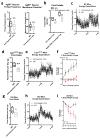Asprosin is a centrally acting orexigenic hormone
- PMID: 29106398
- PMCID: PMC5720914
- DOI: 10.1038/nm.4432
Asprosin is a centrally acting orexigenic hormone
Abstract
Asprosin is a recently discovered fasting-induced hormone that promotes hepatic glucose production. Here we demonstrate that asprosin in the circulation crosses the blood-brain barrier and directly activates orexigenic AgRP+ neurons via a cAMP-dependent pathway. This signaling results in inhibition of downstream anorexigenic proopiomelanocortin (POMC)-positive neurons in a GABA-dependent manner, which then leads to appetite stimulation and a drive to accumulate adiposity and body weight. In humans, a genetic deficiency in asprosin causes a syndrome characterized by low appetite and extreme leanness; this is phenocopied by mice carrying similar mutations and can be fully rescued by asprosin. Furthermore, we found that obese humans and mice had pathologically elevated concentrations of circulating asprosin, and neutralization of asprosin in the blood with a monoclonal antibody reduced appetite and body weight in obese mice, in addition to improving their glycemic profile. Thus, in addition to performing a glucogenic function, asprosin is a centrally acting orexigenic hormone that is a potential therapeutic target in the treatment of both obesity and diabetes.
Conflict of interest statement
No competing financial interests exist for any of the authors.
Figures






References
-
- O’Neill B, Simha V, Kotha V, Garg A. Body fat distribution and metabolic variables in patients with neonatal progeroid syndrome. Am J Med GenetA. 2007;143A:1421–1430. - PubMed
-
- Jacquinet A, et al. Neonatal progeroid variant of Marfan syndrome with congenital lipodystrophy results from mutations at the 3′ end of FBN1 gene. Eur J Med Genet. 2014;57:230–234. - PubMed
-
- Even PC, Nadkarni NA. Indirect calorimetry in laboratory mice and rats: principles, practical considerations, interpretation and perspectives. Am J Physiol Regul Integr Comp Physiol. 2012;303:R459–76. - PubMed
MeSH terms
Substances
Grants and funding
LinkOut - more resources
Full Text Sources
Other Literature Sources
Molecular Biology Databases
Research Materials
Miscellaneous

